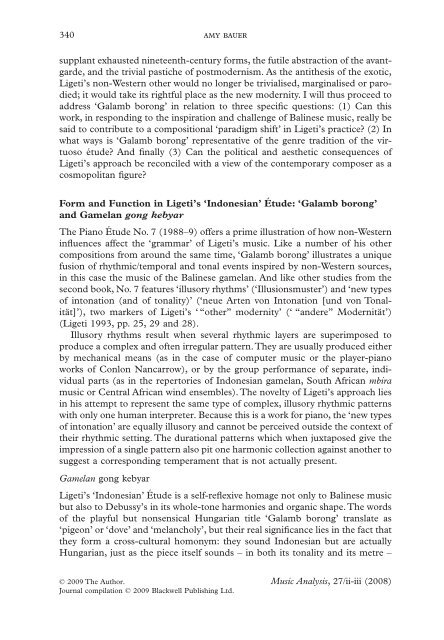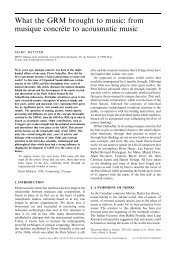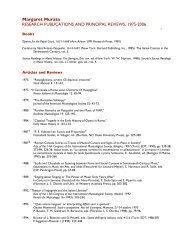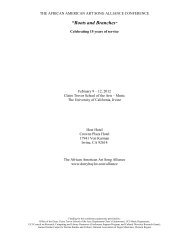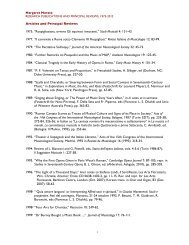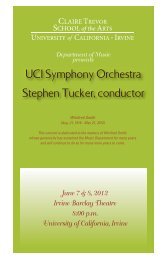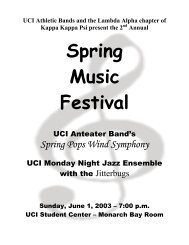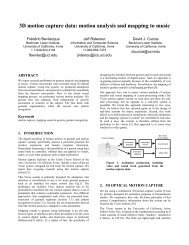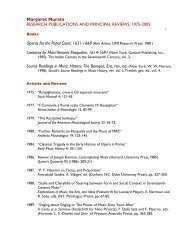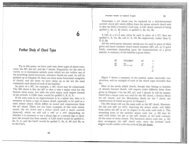amy bauer The Other of the Exotic: Balinese Music as Grammatical ...
amy bauer The Other of the Exotic: Balinese Music as Grammatical ...
amy bauer The Other of the Exotic: Balinese Music as Grammatical ...
You also want an ePaper? Increase the reach of your titles
YUMPU automatically turns print PDFs into web optimized ePapers that Google loves.
340 <strong>amy</strong> <strong>bauer</strong><br />
supplant exhausted nineteenth-century forms, <strong>the</strong> futile abstraction <strong>of</strong> <strong>the</strong> avantgarde,<br />
and <strong>the</strong> trivial p<strong>as</strong>tiche <strong>of</strong> postmodernism. As <strong>the</strong> anti<strong>the</strong>sis <strong>of</strong> <strong>the</strong> exotic,<br />
Ligeti’s non-Western o<strong>the</strong>r would no longer be trivialised, marginalised or parodied;<br />
it would take its rightful place <strong>as</strong> <strong>the</strong> new modernity. I will thus proceed to<br />
address ‘Galamb borong’ in relation to three specific questions: (1) Can this<br />
work, in responding to <strong>the</strong> inspiration and challenge <strong>of</strong> <strong>Balinese</strong> music, really be<br />
said to contribute to a compositional ‘paradigm shift’ in Ligeti’s practice? (2) In<br />
what ways is ‘Galamb borong’ representative <strong>of</strong> <strong>the</strong> genre tradition <strong>of</strong> <strong>the</strong> virtuoso<br />
étude? And finally (3) Can <strong>the</strong> political and aes<strong>the</strong>tic consequences <strong>of</strong><br />
Ligeti’s approach be reconciled with a view <strong>of</strong> <strong>the</strong> contemporary composer <strong>as</strong> a<br />
cosmopolitan figure?<br />
Form and Function in Ligeti’s ‘Indonesian’ Étude: ‘Galamb borong’<br />
and Gamelan gong kebyar<br />
<strong>The</strong> Piano Étude No. 7 (1988–9) <strong>of</strong>fers a prime illustration <strong>of</strong> how non-Western<br />
influences affect <strong>the</strong> ‘grammar’ <strong>of</strong> Ligeti’s music. Like a number <strong>of</strong> his o<strong>the</strong>r<br />
compositions from around <strong>the</strong> same time, ‘Galamb borong’ illustrates a unique<br />
fusion <strong>of</strong> rhythmic/temporal and tonal events inspired by non-Western sources,<br />
in this c<strong>as</strong>e <strong>the</strong> music <strong>of</strong> <strong>the</strong> <strong>Balinese</strong> gamelan. And like o<strong>the</strong>r studies from <strong>the</strong><br />
second book, No. 7 features ‘illusory rhythms’ (‘Illusionsmuster’) and ‘new types<br />
<strong>of</strong> intonation (and <strong>of</strong> tonality)’ (‘neue Arten von Intonation [und von Tonalität]’),<br />
two markers <strong>of</strong> Ligeti’s ‘ “o<strong>the</strong>r” modernity’ (‘ “andere” Modernität’)<br />
(Ligeti 1993, pp. 25, 29 and 28).<br />
Illusory rhythms result when several rhythmic layers are superimposed to<br />
produce a complex and <strong>of</strong>ten irregular pattern.<strong>The</strong>y are usually produced ei<strong>the</strong>r<br />
by mechanical means (<strong>as</strong> in <strong>the</strong> c<strong>as</strong>e <strong>of</strong> computer music or <strong>the</strong> player-piano<br />
works <strong>of</strong> Conlon Nancarrow), or by <strong>the</strong> group performance <strong>of</strong> separate, individual<br />
parts (<strong>as</strong> in <strong>the</strong> repertories <strong>of</strong> Indonesian gamelan, South African mbira<br />
music or Central African wind ensembles). <strong>The</strong> novelty <strong>of</strong> Ligeti’s approach lies<br />
in his attempt to represent <strong>the</strong> same type <strong>of</strong> complex, illusory rhythmic patterns<br />
with only one human interpreter. Because this is a work for piano, <strong>the</strong> ‘new types<br />
<strong>of</strong> intonation’ are equally illusory and cannot be perceived outside <strong>the</strong> context <strong>of</strong><br />
<strong>the</strong>ir rhythmic setting. <strong>The</strong> durational patterns which when juxtaposed give <strong>the</strong><br />
impression <strong>of</strong> a single pattern also pit one harmonic collection against ano<strong>the</strong>r to<br />
suggest a corresponding temperament that is not actually present.<br />
Gamelan gong kebyar<br />
Ligeti’s ‘Indonesian’ Étude is a self-reflexive homage not only to <strong>Balinese</strong> music<br />
but also to Debussy’s in its whole-tone harmonies and organic shape.<strong>The</strong> words<br />
<strong>of</strong> <strong>the</strong> playful but nonsensical Hungarian title ‘Galamb borong’ translate <strong>as</strong><br />
‘pigeon’ or ‘dove’ and ‘melancholy’, but <strong>the</strong>ir real significance lies in <strong>the</strong> fact that<br />
<strong>the</strong>y form a cross-cultural homonym: <strong>the</strong>y sound Indonesian but are actually<br />
Hungarian, just <strong>as</strong> <strong>the</strong> piece itself sounds – in both its tonality and its metre –<br />
© 2009 <strong>The</strong> Author.<br />
Journal compilation © 2009 Blackwell Publishing Ltd.<br />
<strong>Music</strong> Analysis, 27/ii-iii (2008)


